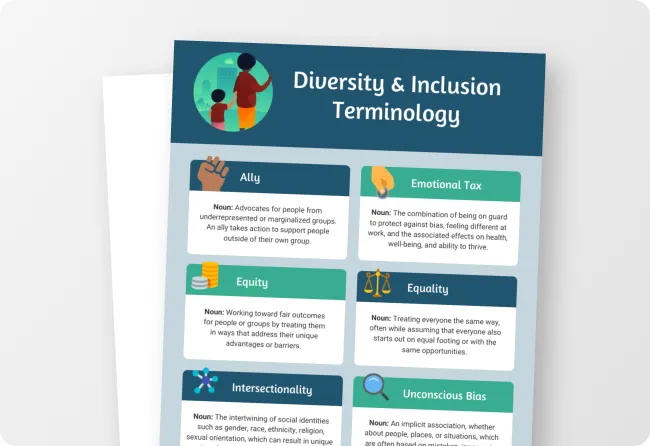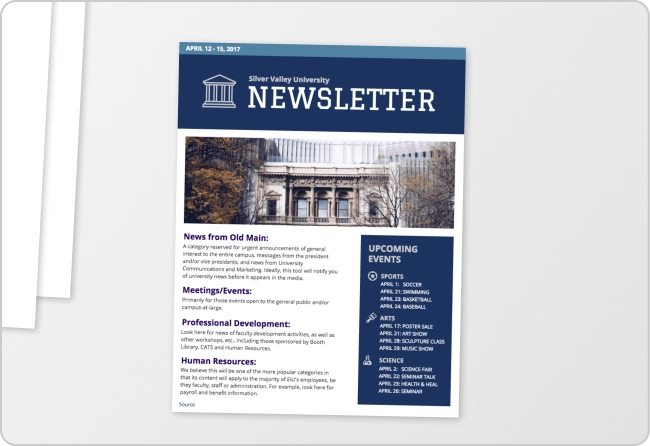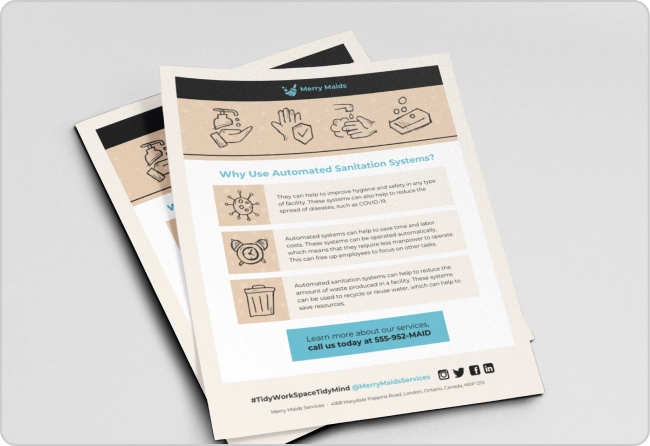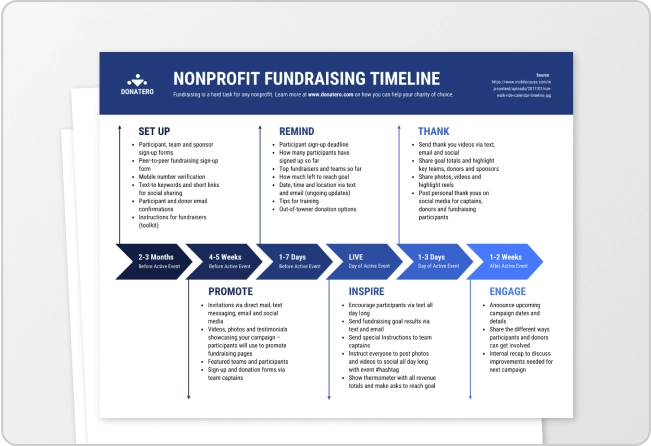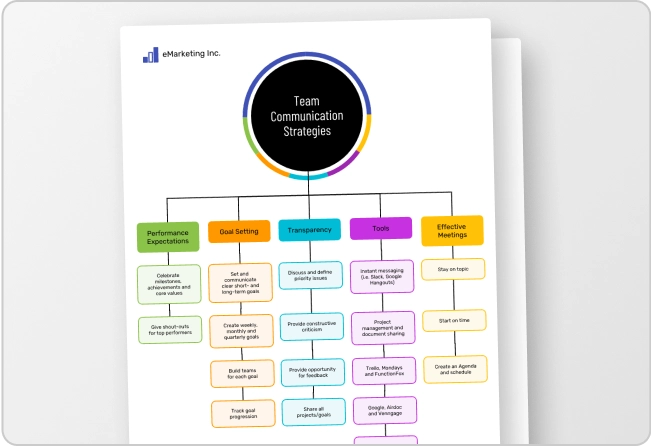A family tree is more than a diagram. it’s your family’s story, mapped out in names, dates and connections. It lets you trace your heritage, discover hidden chapters in your lineage and preserve your legacy for future generations.
For centuries, families have used these charts to strengthen identity and place their personal history within the wider world. Whether you start with a few names or a wealth of records, creating a family tree can be both simple and rewarding.
With a family tree maker or ready-to-use tree diagram templates, you can design a chart that’s accurate, meaningful and easy to share. This guide will walk you through the process step-by-step and share inspiring examples to get you started.
What is a family tree?
A family tree maps out individual’s lineage, visualizing ancestors and generational contributions to their history. Starting with the individual as the “root” and branching out to show their ancestors and descendants. A family tree helps visualize relationships and trace family connections. These diagrams can vary in forms, such vertical, horizontal, circular charts, each illustrating the complexity of one’s heritage.

Based on its name, a family tree is structured like a tree, with the individual as the ‘root’ and their parents, grandparents, and ancestors forming the ‘leaves’ one level at a time.
A family tree uses lines to connect family members and illustrate their relationships. Each family member is represented by a shape like a box or a circle with usually their photo inside.
History of family trees
Genealogy or the study of families was the earliest form and application of family trees.
Historically, in Western civilizations, family trees, also known as genealogy charts, were used to depict the ancestry of kings and nobles and verify their claims to royalty and power.
Family trees were maintained for years on end. The family tree of Confucius, for example, is already 2,500 years old and is recorded as the world’s largest family tree with 2 million known descendants.
Today, a genealogy chart is no longer just for aristocrats and important people, but for everyone to record their family history and maintain their family tree.
Family tree vs. full genealogical research
A family tree diagram is a snapshot — a visual outline of names, dates, and relationships. A full genealogical research project goes much deeper, digging into birth records, marriage certificates, immigration documents and oral histories to uncover stories, timelines, and verified connections.
Benefits of creating a family tree
Benefits of Creating a Family Tree
Building a family tree isn’t just about collecting names and dates, it’s about discovering the people, stories, and connections that shaped your life. The benefits can be personal, historical and even health-related.
Personal benefits
Creating a family tree helps you visualize your ancestry, strengthen your identity and foster a sense of belonging. It can also bring family members closer together, sparking conversations, reconnecting relatives and uncovering stories that might otherwise be forgotten.
Historical benefits
Recording family stories, traditions, and milestones preserves your legacy for future generations. It also lets you see how your family’s timeline intersects with historical events, from migration patterns to major cultural shifts, making history feel personal and alive.
Mapping out your family tree can reveal patterns in health conditions or genetic traits. This information can be shared with healthcare providers, helping you make informed decisions about your wellness and giving future generations valuable insights into their own health history.
Types of family tree diagrams
Choosing the right family tree format can make your research easier to follow and more meaningful to share. The best style depends on your goal, how much detail you have, and whether you want it to be practical, decorative, or both.
Vertical
This is the classic layout — starting with you (or a chosen ancestor) at the bottom and branching upward through generations. It’s straightforward, familiar and perfect for school projects, printed keepsakes or simple presentations.
Horizontal
A side-to-side design that gives you extra room for details like birthplaces, wedding dates and photos. If you want to highlight personal stories alongside the names, this layout gives you the space to do it without feeling cramped.
Circular
Radiates outward from a central starting point, making it visually striking and ideal for showing many generations in one view. Works beautifully for display pieces at family gatherings or as a framed memento for your home.
Fan Charts
Spreads in a half-circle or fan shape, packing several generations into a compact space. A smart choice if you have limited wall or page space but still want to see the big picture of your family’s lineage.
Pro Tip: If you’re still unsure which style to choose, think about how you’ll use the tree — for ongoing research, go vertical or horizontal. For a display piece or gift, circular and fan charts add more visual impact.
Best practices for making a family tree
Creating a family tree is easier (and more rewarding) when you follow a few simple best practices:
- Start with what you know: Begin with your immediate family — names, birth dates and relationships — before expanding to extended relatives.
- Verify your information: Cross-check details with birth certificates, marriage records or trusted relatives to avoid errors.
- Choose the right diagram format: Pick vertical, horizontal, circular or fan charts based on how much detail and space you need.
- Include photos and stories: Adding faces and personal anecdotes makes your family tree feel alive, not just factual.
- Label generations clearly: Use consistent markers (e.g., Roman numerals or generation numbers) so readers can follow the lineage easily.
- Note important dates and places: Include birthplaces, wedding locations or migration details for historical context.
- Keep a master record: Maintain a digital or written copy with all source references for accuracy and future updates.
- Share and collaborate: Involve family members in filling gaps and verifying stories so that it can turn into a bonding project.
How to create your family tree diagram
To start creating your family tree diagram, simply follow these steps:
Step 1: Research information and prepare it
Collect information about your family to start creating a family tree. Use birth records, DNA tests, and talk to a relative of your family who knows about your ancestry.
For those of Asian descent, you can trace your Asian heritage with these DNA tests, offering a detailed exploration of your ancestral roots.
The amount of information you collect will determine the tree’s size and detail. Determine the number of generations and the data to include, such as maiden names, birth years, and family roles.
Step 2: Draft the family tree drawing
Draw your family tree by starting with a box representing yourself or a chosen ancestor. Family trees can be illustrated either from the top, bottom or horizontally as long as the root will always be yourself.
An example of a family tree that’s drawn horizontally:

Consider using an intuitive design tool like Venngage’s Family Tree Maker, if you want to save time and avoid drawing by hand. This tool is designed for both designers and non-designers, making it incredibly easy to use.
With Venngage’s Family Tree Maker, you can better visualize your family tree through its user-friendly drag-and-drop editor. You can quickly change and connect shapes, add labels, and customize colors and design elements in just seconds.
Plus, we have dozens of free templates that you can customize to make the process even faster and easier.
Step 3: Label the family tree’s leaves
Most family trees usually outline up to four generations only to make them easier to understand. That said, make sure that family members and their relationships with each other are clearly illustrated by labeling each box or ‘leaf’ correctly.
Add names, roles, and any additional information you find relevant. Use lines to show relationships between spouses and connect parents with direct descendants like children and grandchildren.
Step 4: Design the family tree diagram
Design and refine your family tree diagram to finalize your family tree. Use family photos to add faces to the people you want to represent with your tree. Color-coordinate shapes, lines, or labels to group generations, differentiate deceased from living relatives, and create a distinction between different relationships.
To make your family tree more attractive and engaging, you can add icons, graphics, illustrations, or backgrounds – all of which are provided for free in Venngage’s library. You can also utilize a family tree software to streamline research and access to valuable resources.
Family history research tips
Digging into your family history can feel like detective work — exciting, but sometimes overwhelming. These tips will help you gather accurate information, avoid common mistakes and make the process enjoyable from start to finish.
How to verify records and gather reliable data
Don’t rely on just one source. Cross-check names, dates and places using birth, marriage and death certificates, census data, church records and immigration documents. Talk to older relatives for stories, but confirm them with official records so your tree stays accurate.
Recommended free genealogy resources and websites
You don’t need a paid subscription to get started. FamilySearch.org, National Archives and Find a Grave offer huge collections of records for free. Your local library, archives or historical society might also have digitized documents, photos or maps you can access at no cost.
Common pitfalls and best practices
One of the biggest traps is copying someone else’s online tree without fact-checking it. Always verify, label unconfirmed information and keep detailed notes on where each fact came from. Staying organized now will save you headaches later and make it easier to share your findings with family.
Real-life case study
When author Gail Lukasik began researching her family tree, she expected to uncover dates, names and maybe a few colorful stories. What she found instead changed her understanding of her identity.
Through birth certificates, census records and historical archives, Lukasik discovered that her mother, Alvera Frederic Kalina, had been born in New Orleans as “colored” but had lived her entire adult life passing as white — a fact she kept secret from her family.
This revelation, later shared in Lukasik’s memoir White Like Her: My Family’s Story of Race and Racial Passing, shows how genealogy isn’t just about filling out branches on a chart, it can uncover hidden histories, reshape family narratives and preserve complex legacies for future generations.
10 Family tree examples
Here are some family tree examples for inspiration that you can use to create a family tree:
1. Simple family tree
This simple family tree template has a distinguishable tree-like shape and features such as branches and colors. It is editable in Microsoft Excel and Word.

2. Ancestry family tree
Use the below template if you want a unique and more effectively illustrated family tree. It has a horizontal layout with the starting point placed in the middle and extending to the left and right to better display ancestors from both sides of the family:

3. Blank family tree
For a more organized and unified family tree, this template is what you should use. It focuses on the structure of the tree and the arrangement of its parts through clearly defined connections and allotting only small spaces for each family member:

4. Graphic family tree
Use below template if you want to represent family members with icons or graphic illustrations instead of photos. It also uses roles as labels instead of names, which is more effective at portraying relationships.

Source: TemplateLab
5. Four generation family tree
Here’s a great example of a family tree that illustrates four generations of family members. Below template will come in handy if you want your family tree diagram to focus on distant relatives instead of immediate family members.
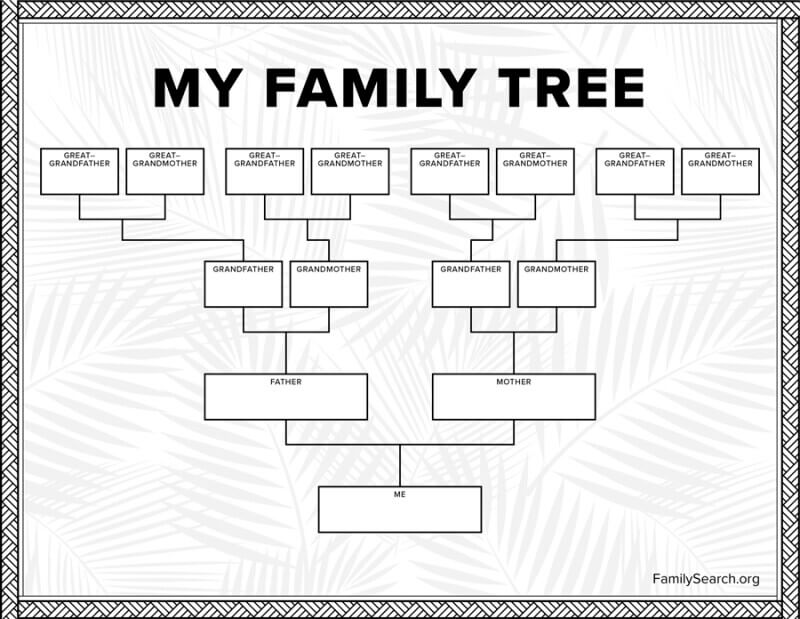
6. Vertical family tree
The most familiar style — starting with you (or a chosen ancestor) at the bottom and branching upward. Works well if you want a simple, direct view of your lineage without extra visual complexity.

7. Horizontal family tree
Grows from side to side, giving extra space for details like photos, locations or life events. A good choice if you’re telling richer stories about each family member alongside names and dates.

8. Circular family tree
Radiates outward from a central starting point. Striking to look at and perfect for displaying multiple generations at once. Often used when the tree will be framed, printed or presented as art.

Source: Family Tree Factory
9. Fan chart
Spreads out like a half-circle, making it compact but still able to show several generations. Great if you have limited wall or page space but still want a complete generational view.

Source: Progeny Genealogy
10. Mixed-style tree
Combines formats — for example, a vertical chart for direct ancestors and a circular section for extended family. Ideal when your research includes different branches that deserve their own spotlight.
Should you create a family tree?
Yes, you should definitely make your own family tree to know more about your family history or documentation purpose.
It is also a great way to find out how your family story relates to important historical events.
More importantly, a family tree can help you identify genetic traits and conditions that run in your family. These are often referred to as genograms.
Related: 10+ Genogram Examples (and How to Create Them)
FAQs about family tree diagrams
How do I verify historical records?
Always cross-check information from multiple sources — such as birth, marriage and death certificates, census records, church registers and immigration documents. If details conflict, prioritize official records over anecdotal ones and keep notes on where each fact came from.
What mistakes should I avoid when building a family tree?
Avoid relying on just one source or copying online trees without verification. Don’t skip adding source citations, they’re essential if you or someone else revisits the research later. Also, watch out for mixing up people with similar names in the same region or time period.
What records should I collect for my family tree?
Gather core documents like birth, marriage and death records, census data, land deeds, military records and obituaries. Supplement them with photos, letters, diaries and oral histories to add depth to your family’s story.
How often should I update my family tree?
Update whenever you uncover new information, whether it’s a newly discovered ancestor, corrected birth date or added photo. A periodic review (once or twice a year) helps keep your tree accurate and up to date.
Can I collaborate with other family members on my family tree?
Yes! Collaboration can fill in missing details, add personal stories and help verify facts. Digital tools make it easy to share editable versions or invite family members to contribute their knowledge.
Which tools or software are best for creating family tree diagrams?
Popular options include FamilySearch, Ancestry and MyHeritage for research and record storage.
When it comes to creating a family tree, you have plenty of options including traditional tools like Microsoft Word or PowerPoint.
However, consider Venngage if you’re looking for a user-friendly and visually appealing experience. We provides customizable family tree templates, allowing you to personalize and showcase your family connections with ease. The easy-to-use interface simplifies the process, making it easy for anyone to create a unique and engaging family tree.
Visualize family relationships with Venngage’s Family Tree Maker.
Making a family tree diagram can help you learn about your family history and understand the connections between family members. Use Venngage’s Family Tree Maker to create a well-defined family tree.




























